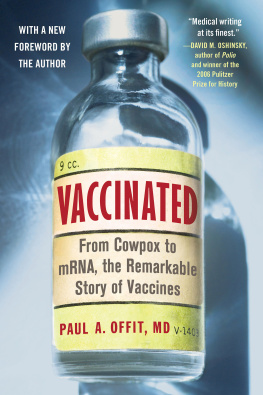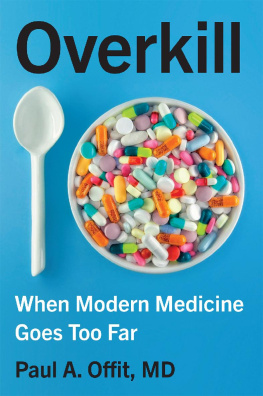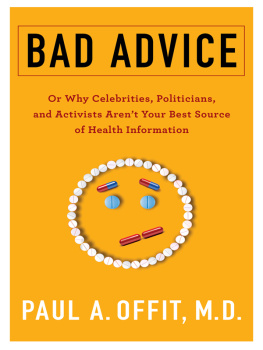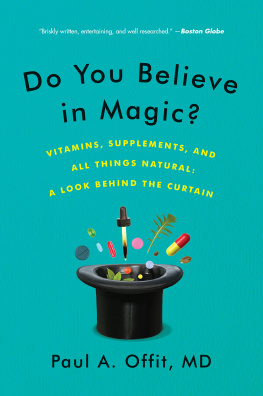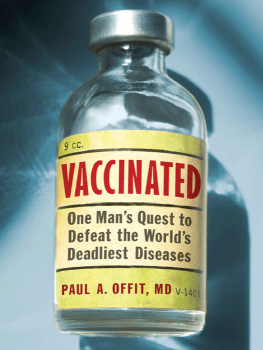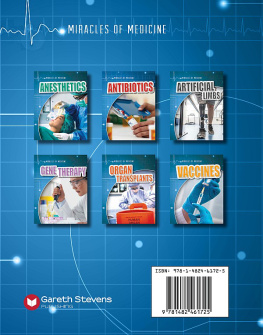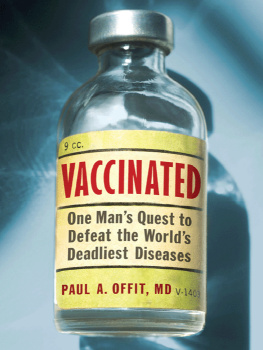F OR B ONNIE,
WHO MADE DREAMS COME TRUE,
AND FOR OUR CHILDREN, W ILL AND E MILY,
THE TWO METEORS STREAKING THROUGH OUR LIVES
And now, cried Max, let the wild rumpus start.
M AURICE S ENDAK , W HERE THE W ILD T HINGS A RE
Contents
I n November 2019, a bat coronavirus made its debut in the human population. By July 2021, more than 200 million people had been infected and four million killed. The virus was called SARS-CoV-2 and the disease COVID-19. One hundred years had passed since the world had experienced a pandemic of this magnitude.
There was, however, a way out: vaccines. For more than two hundred years, vaccines have had a remarkable record of success:
- Smallpox, a disease that killed more than 500 million people and changed the arc of European history, has been eliminated from the face of the earth.
- Rabies, a disease with a mortality rate of 100 percent, can now be prevented.
- Yellow fever, a virus that infected 50,000 people and killed 5,000 in Philadelphia in a single year, has been eliminated from the United States and Europe.
- Polio, a disease that caused 30,000 children to be paralyzed and 1,500 to die every year, was, by the late 1970s, eliminated from the United States. By 2020, a campaign by the World Health Organization (WHO) had eliminated two of the three types of polioviruses that cause disease.
- Measles, a disease that caused 50,000 hospitalizations and 500 deaths a year, was, by 2020, no longer spreading in the United States. Worldwide, measles deaths have declined from 2.6 million to 200,000 a year.
- The mumps vaccine has virtually eliminated the most common cause of acquired deafness, causing many homes for the deaf to close their doors.
- Rubella (otherwise known as German measles), a virus that when it infected pregnant women caused as many as 20,000 cases of permanent birth defects and 5,000 spontaneous abortions every year, was, in 2005, eliminated from the United States. Worldwide, during the past twenty years, the rubella vaccine has reduced the number of cases from 670,000 to 49,000.
- The chicken pox vaccine has caused a 99 percent reduction in the 10,000 hospitalizations and one hundred deaths caused by the virus every year in the United States.
- A vaccine against Haemophilus influenzae type b (Hib), a bacterium that caused 25,000 cases of bloodstream infections and meningitis every year, has reduced that number to fewer than fifty. Vaccines against other bacteria, such as pneumococcus and meningococcus, which also cause bloodstream infections and meningitis, have dramatically reduced the incidence of those diseases.
- Before the hepatitis B vaccine, the virus infected 18,000 children younger than ten years of age every year in the United States, most destined to develop long-term liver disease (cirrhosis) and liver cancer. After the hepatitis B vaccine was routinely recommended for newborns in the early 1990s, the infection has been virtually eliminated in children. Further, thanks to the Bill and Melinda Gates Foundation, the hepatitis B vaccine has now been given to more than 85 percent of the worlds population.
- A vaccine against human papillomavirus has resulted in an appreciable decline in the incidence of cervical cancer in several population studies.
- A vaccine against rotavirus, an intestinal virus that killed 500,000 babies every year in the world, is now saving hundreds of lives every day.
In short, because of vaccines, we live thirty years longer than we did a hundred years ago. Unfortunately, as is true in a war against any enemy, casualties occur on both sides. We learn as we go. And that knowledge often comes with a human price. Sadly, the story of vaccines is also littered with tragedy. For example:
In March 1942, the Office of the Surgeon General noted a growing incidence of jaundice among U.S. army personnel who had recently received a yellow fever vaccine that contained human serum as a stabilizing agent. The serum had been obtained from health care workers at Johns Hopkins Hospital in Baltimore, several of whom had a history of jaundice and one of whom was actively infected at the time of the donation. When the dust settled, 330,000 service members had been infected and one thousand had died from what would later be called hepatitis B virus. It was one of the worst single-source outbreaks of a fatal infection ever recorded.
In 1955, five pharmaceutical companies stepped forward to make Jonas Salks polio vaccine. One, Cutter Laboratories of Berkeley, California, made it badly, failing to fully inactivate the virus. As a result, 120,000 children were inoculated with live, fully virulent polio virus; 40,000 were temporarily paralyzed, 164 were permanently paralyzed, and 10 were killed. It was arguably the worst biological disaster in American history.
In the early 1960s, a vaccine to prevent respiratory syncytial virus, a common cause of pneumonia in young children, was made by taking the virus and inactivating it with a chemical in much the same way that Jonas Salk made his polio vaccine. Researchers were hopeful that they now had a way to prevent a virus that killed five thousand babies every year in the United States. It didnt work out that way. Early studies found that children who were vaccinated were more likely to be hospitalized and more likely to die from pneumonia when later exposed to the virus than those who were never vaccinated. A similar problem occurred with two early versions of the measles vaccine, both of which were quickly removed from the market.
Knowing that the road to successful vaccines is often bumpy and occasionally fraught with dangers, the development of vaccines against SARS-CoV-2 has, for several reasons, been one of the most remarkable scientific achievements in the past two hundred years.
SARS-CoV-2 is an elusive virus. When public health officials in China billed SARS-CoV-2 as a respiratory virus that, like influenza, could cause severe and occasionally fatal pneumonia, they had severely underestimated its heinous nature. COVID-19 is far worse than anyone could have imagined. Within a year, the virus was discovered to have several clinical and pathological features that both surprised and confounded doctors and researchers. Specifically:
In addition to infecting the lungs, SARS-CoV-2 virus caused people to make an immune response against the lining of their blood vessels, thus causing inflammation (vasculitis). Because every organ in the body has a blood supply, every organ could be affected.
SARS-CoV-2 could cause people to lose their sense of taste and smell, often for weeks at a time.
Neuropathologists have detected SARS-CoV-2 virus in the brains of some people with COVID-19.
Children with mild or asymptomatic infections, who would rid themselves of the virus within a couple of weeks, would later be hospitalized with high fever and lung, liver, heart, and kidney disease. This postinfection phenomenon, called multisystem inflammatory syndrome in children (MIS-C), occurred in about one of every one thousand children infected and was occasionally fatal. Many children continued to experience symptoms more than two months later, so-called long-haulers. This same syndrome can also occur in adults.
SARS-CoV-2 virus causes inflammation of the heart muscle (myocarditis). A study performed in athletes in the Big Ten Conference found that one of every forty-three young men and women with COVID-19 had evidence of myocarditis.
No other respiratory virus does these things.
Perhaps worst of all, SARS-CoV-2 was constantly mutating, constantly trying to adapt itself to growth in people. The virus that first appeared in Wuhan, China, (called 2019-nCoV) was not the virus that left that country. That virus, called D614G, was the first significant mutation (or variant). And it was far more contagious than the original virus. Indeed, it was the D614G variant that swept across Asia, Europe, and the United States, killing millions of people, only to be replaced by yet another variant, the alpha variant, which was even more contagious. But SARS-CoV-2 wasnt finished mutating. The alpha variant was later replaced by the even more contagious delta variant. As the variants became more and more contagious, a greater and greater percentage of the population needed to be vaccinated to stop the spread of the virus.

